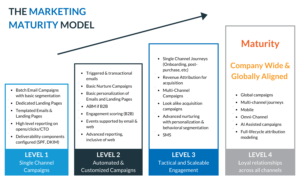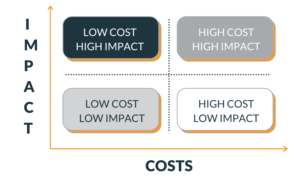In a world that demands always-on, omni-channel engagement options, it’s easy to prioritize having tools over having the people, data, and maturity to operate them effectively. However, you need both to be successful.
The Salesforce ecosystem is big, and it continues to get bigger and better each year. Take Salesforce Marketing Cloud. Since Salesforce acquired ExactTarget in June 2013, it has transformed the technology into what we now know as Marketing Cloud: An immense solution with 10 distinct modules that offer something for nearly everything you could possibly dream up.
This growth is a blessing and a curse. It’s impossible to be an expert in every aspect of marketing these days, and unless you work at a large organization that offers access to people with specialized skills and unlimited resources, you really have to be wise about how your organization matures over time. It’s easy to be distracted by the next trend — and there’s little doubt that Marketing Cloud will enable it — but it’s important to scale your program in a responsible way.
So how can you, as a marketer, prioritize your roadmap for everything from the technology and data, to the people and processes that you need to be successful? Start here.
Roadmap for Salesforce Marketing Cloud: Breaking Down the 4-Step Maturity Curve
Ultimately, every marketing team wants to build a mature program that helps achieve key business goals. The best way to do so is by intelligently using the people and technology available to you to run efficient and effective processes.
Of course, realizing that outcome is far easier said than done. It requires a highly focused approach to growth that scales and matures multiple elements — technology, processes, data, people, etc. — in tandem.
It may not be easy, but when done correctly, this approach can deliver enormous benefits. With that in mind, here’s a look at a 4-step maturity curve that serves as a roadmap for advancing Salesforce Marketing Cloud.

Step 1: Determine How You Will Measure Results
Can you measure your results? For example, can you identify where you lose people in the customer journey and how you can move them along better and faster? Are you having issues with acquisition or are you struggling to convert newly acquired prospects to a stage further along their path to purchase?
If you can’t measure these types of results, you are ultimately throwing money out the window. That’s because measuring results like these will help you identify how you can maximize your spend (in terms of both time and money) and determine the areas (including strategies, tactics and channels) where you most need improvement.
The most basic way to measure results is with Google Analytics (it’s free!) through UTM tags (note: you can also use Adobe or other paid tools) and the standard reports and dashboards provided within Marketing Cloud. From there, as your program matures, your analytics capabilities should mature along with it. Fortunately, Salesforce has several new products to help you do so: Interaction Studio, Einstein, Tableau and Datorama are all products that can work separately or together to improve your reporting capabilities.
Step 2: Identify the Best Strategies, Tactics, Channels and Data for Your Program
Once you have the list of areas in your program that need improvement, it’s time to start looking at the best strategies, tactics, channels and data to help deliver the desired results.
Start by getting back to basics, because if you can’t get the basics right, your chances of being successful are slim to none. Wherever you start, it’s important to first determine the best strategies to affect the change you need and to outline the data required to make those strategies effective.
When it comes to the basics, we recommend looking first at email, landing pages and the data model that underlies those things. Nearly 99% of all Marketing Cloud implementations start with email because it’s still one of the most effective channels available to marketers and it’s a major linchpin for the majority of data models since most transactional communications (purchases, returns, etc.) primarily occur via email. Email is also one of the easier channels in which to make changes and can be woven into any successful omni-channel strategy.
Step 3: Map Your Investment Needs
Next, look at your list of strategies, tactics and data needs. How much of that list do you already have access to that just requires some leveling up? How much of it requires a net-new investment?
Answering these questions should help you map your investment needs and determine how to prioritize them. The best way to do this is to plot the answers in a four box matrix with “Costs” as the X-axis and “Impact” as the Y-axis, as pictured below.

What lands in the upper left, “Low Cost, High Impact” quadrant are the low hanging fruit that you can accomplish relatively easily with existing investments and see big returns quickly. An example of this type of project might be using Journey Builder for an onboarding email series.
What lands in the upper right, “High Cost, High Impact” quadrant are the long term plays that will deliver big returns but will require more time and/or money to achieve. An example of this type of project might be purchasing Mobile Studio and building an app on Heroku to introduce push messaging.
Finally, the lower two quadrants — “Low Cost, Low Impact” and “High Cost, Low Impact” — should be considered secondary, since they will not deliver big returns for your program. This is especially the case for projects that will be “High Cost, Low Impact.”
Step 4: Prioritize Your Options
Finally, you can use your matrix to start prioritizing projects, keeping in mind that even the projects within each quadrant will need to get prioritized. Numerous options exist for helping your team identify and brainstorm areas where you need to focus. One of my favorites is called “Show Me The Money.” I talk through the exercise in this video, but here is a step by step breakdown:
“Show Me The Money” Prioritization Exercise
- Review your current strategy as a team to identify deficiencies
- Assemble a cross-functional team to discuss these deficiencies
- Share the list of potential initiatives with the cross-functional team
- Distribute real money (at least $20) to each person
- Instruct the team to work together to pool their money across the initiatives about which they feel most passionate
- Recap the winning initiatives
- Assign owners to each of the winning initiatives
- Set deadlines for allocating resources and building a plan to enact those initiatives
Building a Mature Program with Salesforce Marketing Cloud — One Step at a Time
“How should we build our program around Salesforce Marketing Cloud?” is a common question — and it has many answers. One of the most typical paths for Salesforce Marketing Cloud adoption is to start in email with basic sends and some light segmentation. From there, teams often branch out into email-only journeys, add the Salesforce Connector to utilize more data and start to do some triggered sends. Finally, SMS and Ad Studio are common add-ons that can be easily folded into journeys to create true omni-channel campaigns.
While this is a typical path, it’s not the only one. The most important thing when charting your own roadmap for Salesforce Marketing Cloud is not to get caught up in the arms race. Instead, focus on what is achievable given your organization’s constraints, be they time, money, personnel or anything else. Pick the initiatives that give you the most bang for your buck, plot out the path to achieve those goals and then once you reach them, go back to your list for the next initiative. When you’ve exhausted the low hanging fruit, move on to some of the bigger ticket items, or work toward those more involved items over a longer period of time while you knock out the easy ones.
Ultimately, Salesforce Marketing Cloud provides a smorgasbord of options from which teams can choose. Whether you’re just getting started or looking to mature your program, having so many options can make it challenging to determine the best place to start. The key to overcoming this challenge is taking platform adoption and program growth one step at a time, as outlined in the roadmap here.
Interested in learning more about how Marketing Cloud can benefit your organization? Contact our experts today!